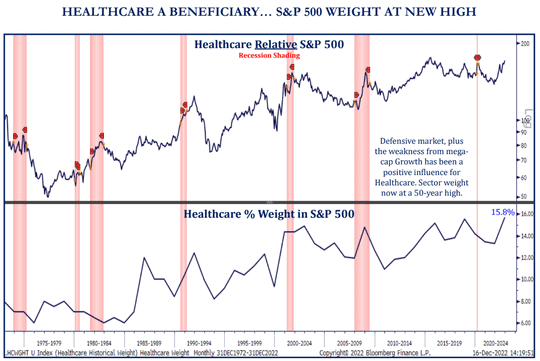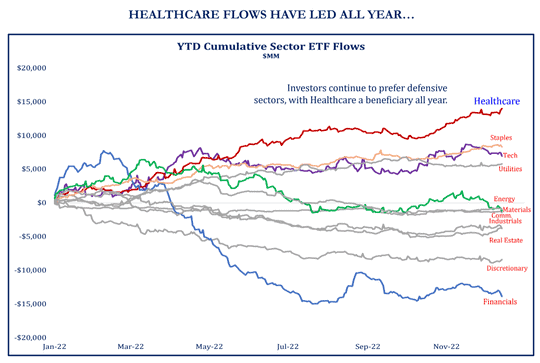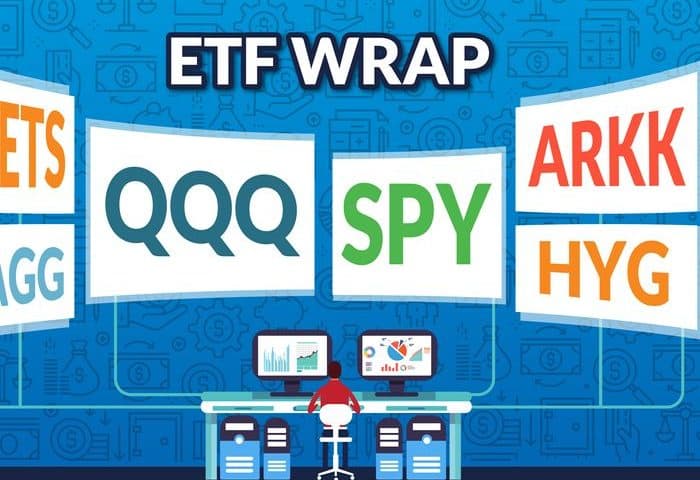The S&P 500’s “FANG-era” is ending, with the waning influence of Big Tech stocks rippling through the exchange-traded fund industry, according to Strategas.
The “concluding” era has boosted healthcare’s heft in the U.S. stock benchmark while giving way to the outperformance this year of an ETF fund tied to an equal-weight version of the S&P 500 index, said Todd Sohn, an ETF strategist at Strategas, in a Dec. 20 note.
More than $7 trillion of assets were indexed to the S&P 500 at the end of 2021, with weakness in megacap growth stocks, or equities known as “FANG,” causing “pain” to many investors in this year’s bear market, Sohn said in the note.
“If you’re a passive investor, it’s not great when your largest weights decline because that makes returns more difficult,” he said in a phone interview.
Shares of the SPDR S&P 500 ETF Trust SPY, which tracks the capitalization-weighted S&P 500 index and had about $357 billion of assets under management on Dec. 20, have plunged 18.7% this year through Wednesday. That’s steeper than the 12.8% drop for the Invesco S&P 500 Equal Weight ETF RSP over the same period, according to FactSet data.
“Bear market resets are what is usually needed to see the ‘average’ stock outperform the cap-weight index,” Sohn wrote in his note. That also helps “take the froth out” of the S&P 500’s largest weights, he said.
So-called FANG stocks were popular in the bull market, an abbreviation referring to Facebook parent Meta Platforms Inc. META, Amazon.com Inc. AMZN, Netflix Inc. NFLX and Google parent Alphabet Inc. GOOG GOOGL. The acronym was later expanded to FAANG to include Apple Inc. AAPL, while another version, FAAMG, replaces Netflix with Microsoft Corp. MSFT.
The heavy influence of Big Tech stocks Apple, Microsoft, Alphabet and Amazon in the S&P 500 is waning, Sohn said by phone. While these tech giants remain the four largest weights in the widely followed benchmark, their collective weight has dropped “meaningfully” to around 17% from as high as 22% in September 2020, according to his note.
In his view, the Invesco S&P 500 Equal Weight ETF may continue to outperform “SPY” as “you have a macro environment where interest rates are rising and the Federal Reserve is still very tight in their policy,” said Sohn by phone. That’s “not good” for tech stocks, particularly growth companies that are unprofitable, he said.
The “concentration risk” among the top five S&P 500 weights is “dissipating and perhaps mean reverting back to the 40-year average of 13%,” according to his note.
Currently, the top 10 weights in the S&P 500 also include Berkshire Hathaway Inc. BRK followed by UnitedHealth Group Inc. UNH, Johnson & Johnson JNJ, Exxon Mobil Corp. XOM, Nvidia Corp. NVDA and Tesla Inc. TSLA, his note shows.
Healthcare ETF becoming ‘larger force’
Healthcare ETFs have risen in popularity this year, with the sector’s weight in the S&P 500 soaring to at least a half-century high, according to Strategas.
“XLV is becoming a larger force” in the S&P 500, Sohn said by phone, referring to the ticker for the Health Care Select Sector SPDR Fund XLV. “As tech influence has declined, healthcare has kind of picked up the slack,” Sohn said, adding that healthcare’s weight in the S&P 500 has risen to about 16%, the highest level in the 50 years of data that he tracks.

A “defensive market, plus the weakness from megacap growth has been a positive influence for healthcare,” Sohn wrote. “Investors continue to prefer defensive sectors, with healthcare a beneficiary all year.”
Healthcare has seen the most ETF inflows this year among sectors, the Strategas note shows.

Healthcare ETFs have attracted $14 billion this year through Dec. 16, with “XLV” representing a large portion of those flows, Sohn said. “XLV” is on track for a record year, pulling in $7.7 billion in 2022 over the same period, he said. That’s up from $3.8 billion of inflows for the ETF last year, according to Sohn.
Other popular healthcare ETFs this year have included the iShares Biotechnology ETF IBB and iShares U.S. Medical Devices ETF IHI, Sohn said.
ARK’s ‘loyal’ investors
Tech and growth stocks have been hit particularly hard in 2022.
But many investors in ARK Investment Management founder Cathie Wood’s flagship ARK Innovation ETF ARKK seem to have remained “loyal” despite the fund’s dismal performance since its peak last year, according to Sohn.
The actively managed ETF, which targets disruptive innovation, has plummeted 79.1% from its Feb. 12, 2021 peak based on its closing price Wednesday, according to FactSet data. This year, the fund has dropped 65.4% through Wednesday.
The ARK Innovation ETF is “very emblematic” of the “speculative boom” seen in the wake of the COVID-19 crisis in 2020 and the subsequent suffering of its holdings as the Fed tightens its monetary policy by raising interest rates to combat high inflation, Sohn said in the phone interview.
Still, Wood’s flagship ETF, whose top holdings include Tesla, has “a very loyal investor base,” he said. “They have not thrown in the towel yet as a whole.”
The fund has attracted a net $1.5 billion of inflows this year through Dec. 16, while garnering a net $810 million since its February 2021 peak, Sohn said by phone.
Meanwhile, shares of electric-car maker Tesla also have plummeted in 2022, down almost 61% through Wednesday.
For its part, Federated Hermes has positioned its balanced portfolios with “a very modest underweight to stocks,” while being “significantly underweight bonds” and “max overweight cash,” according to Stephen Auth, chief investment officer of equities at the investment firm. Within equities, Federated Hermes is “max underweight growth stocks” and “max overweight defensive, value stocks,” particularly dividend stocks, Auth said by phone.
Last month, the firm launched the Federated Hermes U.S. Strategic Dividend ETF FDV, an actively managed fund that seeks to invest in high dividend-paying stocks. Shares of the fund are down 2.5% this month through Wednesday, compared with a 4.9% drop for the S&P 500.
As usual, here’s your look at the top- and bottom-performing ETFs over the past week through Wednesday, according to FactSet data.

New ETFs
- Tidal Financial Group, an ETF investment and technology platform, announced on Dec. 19 the launch of the YieldMax TSLA Option Income Strategy ETF TSLY and the YieldMax Innovation Option Income Strategy ETF OARK. The funds are actively managed by ZEGA Financial. Tidal said that TSLY and OARK “pursue a synthetic covered call strategy” on Tesla and the ARK Innovation ETF, respectively.
- John Hancock Investment Management said Dec. 21 that it has launched the John Hancock International High Dividend ETF JHID, an actively managed fund that seeks “a high level of current income, with long-term growth of capital as a secondary objective.”

